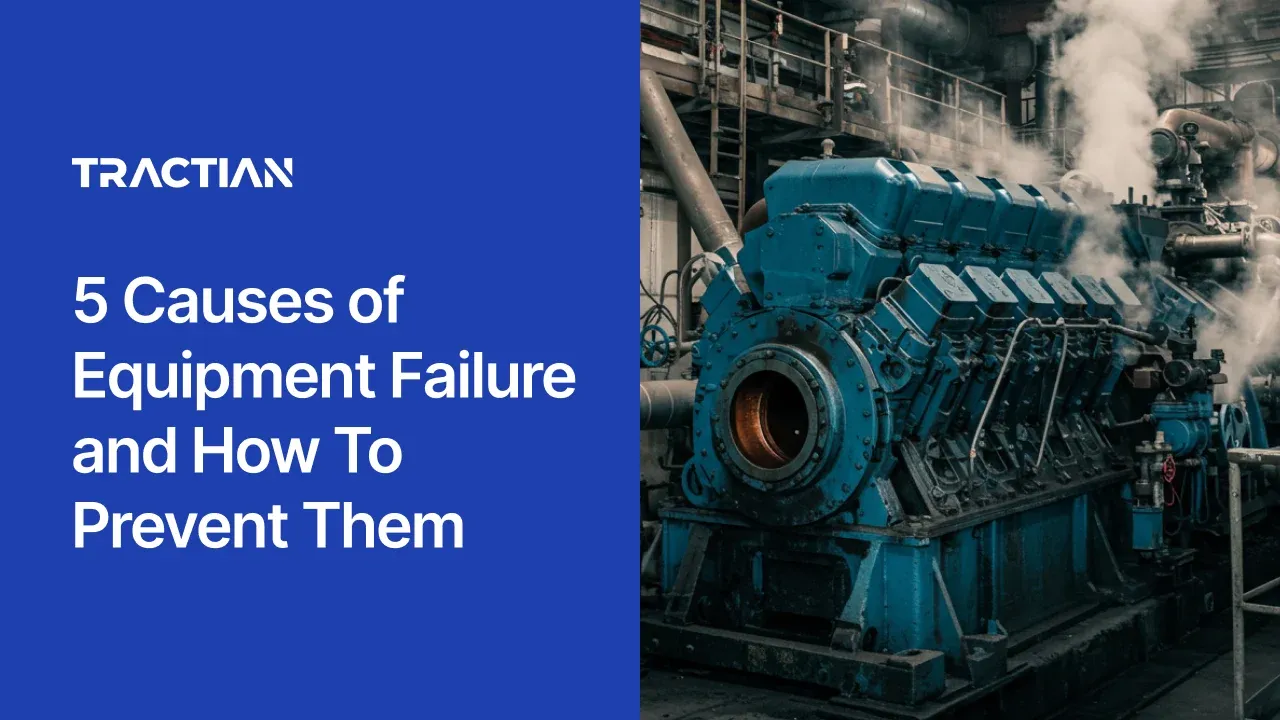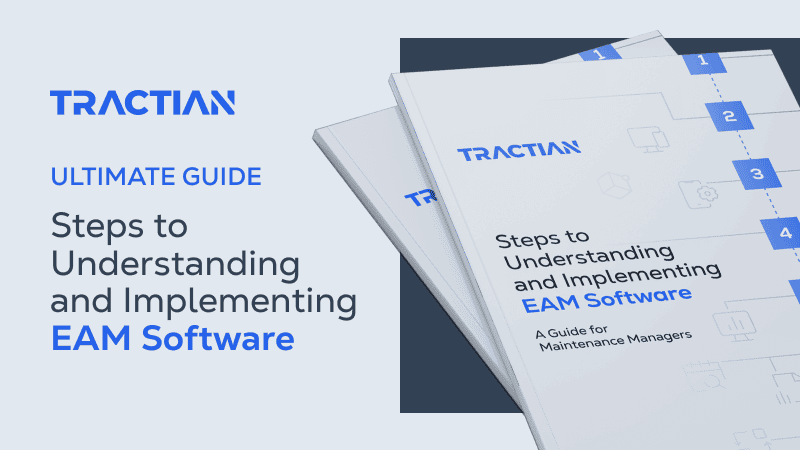When a machine goes down, there are ripple effects throughout the plant floor. From lost production and delayed orders to frustrated teams, equipment failure is one of the most disruptive and expensive challenges in industrial operations.
It doesn’t just halt production, it triggers a cascade of unplanned obstacles teams have to scramble to fix. But while the outcomes of equipment failure are clear, the causes often go unaddressed until it’s too late.
The truth is, most common equipment failures are preventable, and they usually point to deeper issues in how maintenance is planned and executed.
Understanding these root causes and proactively working to solve them is the first step toward a more reliable, controlled operation.
In this article, we'll cover the five leading causes of industrial equipment failure and how to prevent them.
What Is Equipment Failure?
Equipment failure happens when a machine or asset stops performing its intended function. That doesn’t just mean shutting down completely; it can also include partial failures like performance drops, irregular behavior, or quality defects.
In manufacturing, failure is defined by its impact. If a component’s condition causes production to fall below specification, it has failed.
Failures can be sudden, like a motor burning out, or gradual, like a bearing wearing down over time. They might be mechanical, electrical, or even software-related, but the outcome is the same: unplanned downtime, inefficiency, and increased costs.
Equipment Failure Is More Costly Than You Think
Even a single hour of equipment failure can rack up losses faster than most teams realize.
According to Siemens' True Cost of Downtime 2024 report, the world’s 500 largest manufacturers lose $1.4 trillion every year to unplanned downtime. That’s 11% of their total revenue evaporating because of disrupted operations.
And the financial hit isn’t limited to the biggest companies. For an average plant, downtime now costs upwards of $253 million annually.
In the automotive industry for example, every silent hour on a major production line costs $2.3 million. That’s more than $600 every second, a number that’s quadrupled since 2019.
So why are these costs rising so fast?
It comes down to more complex systems, rising energy prices, and increasingly interconnected supply chains. A failure in one part of the line creates ripple effects across multiple teams and production stages, widening the damage with each passing minute.
Small and mid-sized manufacturers are particularly vulnerable, with some losing as much as $150,000 an hour when operations stall. For companies that rely on delivering OTIF (On Time, In Full), one missed order could jeopardize key contracts or their status as a supplier altogether.
What Are Some Types of Equipment Failure?
Not all failures look the same, and not all of them stop machines in their tracks.
To build an effective failure prevention strategy, you first need to understand the different ways assets fail:
Sudden Failure
This is the classic case of one moment the equipment is running, the next it’s not. These failures typically involve critical components and cause immediate downtime.
Think of a fractured shaft or a bearing that seizes without warning. These are high-impact events and often point to gaps in condition monitoring or inspection routines.
Intermittent Failure
Intermittent failures show up inconsistently and are the most frustrating to diagnose. Machines might work fine during one shift, then malfunction the next.
They’re often tied to thermal expansion, fluctuating loads, or marginal electrical contacts. And heads up: If they’re not tracked closely, intermittent failures generate inconsistent data that clouds your root cause analysis.
Gradual Degradation
This type of failure builds over time. Performance may dip, but the asset keeps running. Degradation typically shows up in systems where wear is constant but predictable, like pump impellers or filters.
The danger here is normalization: teams get used to poor performance until it leads to a bigger problem.
Hidden Failure
Hidden failures are dangerous because they’re not obvious until another component triggers them. For example, a faulty pressure sensor may not alert the team until a downstream pump runs dry.
These failures are usually tied to protective systems like alarms, interlocks, and backups.
5 Common Causes of Equipment Failure
When failure strikes, it’s rarely a coincidence. Most breakdowns stem from predictable and preventable underlying issues. Here are the five most common underlying causes:
1. Aging Equipment
Older assets don’t just carry wear and tear, they carry hidden risks that slowly accumulate across cycles, shifts, and maintenance interventions.
The problem with aging equipment isn’t just that parts wear out. It’s that this degradation becomes harder and harder to predict over time. Bearings loosen beyond what vibration baselines can detect.
Electrical insulation breaks down intermittently under load. Even documentation can be outdated or missing, making inspections and repairs a guessing game.
And aging equipment often gets overlooked because it’s “still running.” Teams get used to the noise, the heat, etc. Performance loss becomes normal, even when it’s clearly measurable. At some point, that tolerance becomes a liability.
What’s more, maintenance teams working with older fleets often face these constraints:
- OEM no longer supports the model: spares are either refurbished or sourced from secondary markets.
- Asset history is fragmented or incomplete, making RCA nearly impossible.
- No digital baseline exists for performance.
If you want to extend your asset’s lifecycle, it has to be done with real-time monitoring and structured lifecycle tracking. Otherwise, you’re not saving money, you’re just rolling the dice.
2. Operator Error
Not every failure starts with a faulty part. Sometimes, it’s a switch flipped too soon or a bypass valve left open. And in environments where precision matters, even minor lapses lead to major disruptions.
Operator error is one of the most underreported but most consequential causes of equipment failure. It includes everything from incorrect startups to improper loading.These mistakes usually stem from systemic issues like a lack of standardized work procedures or a poor human-machine interface (HMI) design.
That leads to failure events that mimic mechanical faults, but are rooted in improper handling. This ultimately masks the real issue: lack of operational discipline.
3. Lack of Preventive Maintenance
Lack of preventive maintenance remains one of the most persistent causes of equipment failure in industrial environments. And it’s not just about skipping PMs, but also about the absence of a structured, risk-based strategy that aligns asset criticality with failure likelihood.
Too often, maintenance is performed reactively, leaving teams little time and resources to actually address the root problems of these failures. What’s missing is a proactive plan that accounts for usage patterns, failure history, and condition thresholds.
This is where the difference between run-to-failure and preventive maintenance matters.
Run-to-failure might make sense for low-cost, non-critical components. But applied across the board, it creates a risky backlog that often ends up disrupting production schedules.
Preventive maintenance reduces those risks before they escalate. It targets known failure modes and helps extend useful asset life without over-servicing.
Still, many teams fall into a false economy of sorts. They delay scheduled work to keep production running, only to pay more later when the machine fails at the worst possible time.
4. Over-Maintenance
Yes, there is such a thing as too much maintenance.
Too many interventions disrupt stable systems, introducing unnecessary risks. For example, every time a machine is adjusted without a clear justification, the chance of failure increases.
Over-maintenance usually comes from good intentions. Teams follow rigid schedules without considering actual asset conditions. Components get replaced too early. Lubrication is applied too frequently. And PMs are performed on assets that don’t need them.
Ironically, all this extra work actually reduces machine reliability over time. But with real-time performance metrics and historical failure patterns, teams can shift from blanket scheduling to precision-based planning.
The goal isn’t to do more maintenance. It’s to do the right maintenance, at the right time, for the right reason.
5. Bad (or No) Reliability Culture
The most advanced maintenance tech can’t fix a poor reliability culture. If failure is treated as normal and operators don’t communicate with technicians, problems will continue.
A solid reliability culture means everyone on the floor understands the value of uptime and is empowered to protect it. In practice, this looks like building a shared mindset around continuous improvement.
Without this foundation, even the best preventive maintenance strategies will fall short. Reliability has to be built into the way teams think, not just the way they work.
With all that said, how can teams best prevent failures?

5 Ways to Prevent Equipment Failure
Reducing failure rates is about consistency and purpose.
These five strategies can help your maintenance team shift from firefighting to precision, so your operations can extend asset life and keep costs in check.
1. Provide Thorough Operator Training & Maintain Compliance
Operators are the first line of defense against failure. But without proper training, that proximity turns into risk.
Training isn’t just onboarding, it’s an ongoing process. It must include hands-on work with the actual equipment, along with scenario-based troubleshooting.
Teams also need refreshers on things like safety protocols and startup/shutdown sequences, especially when equipment is updated or reconfigured.
Beyond that, compliance plays a key role. A lot of failures happen not because the team doesn’t know what to do, but because protocols aren’t enforced. Without consistent audits, procedural discipline breaks down, and small deviations accumulate into big problems.
A maintenance software like a CMMS can help your team stay on track.
2. Monitor & Analyze Equipment Digitally
The problem with manual checks is that they can’t keep pace with how complex today’s asset fleets are. This is why real-time insights from connected equipment are essential to predicting failure before it happens.
Digital monitoring solutions give maintenance teams a continuous view of asset health by tracking vibration, temperature, current, and other key indicators.
More importantly, these systems detect changes before symptoms become visible, bridging the gap between normal wear and unexpected breakdown.
Tractian’s solution tracks equipment behavior across multiple variables, helping identify early-stage failure conditions and prioritize responses accordingly.
3. Balance Preventive with Condition-Based Maintenance
Preventive maintenance works until it becomes excessive. Like we mentioned before, performing tasks too often can increase failure risk and burn through resources. That’s where condition-based maintenance acts as a counterbalance.
The key is to shift from a fixed-interval mindset to one guided by actual equipment condition. Instead of changing bearings every six months, teams respond to vibration thresholds. Instead of relying on runtime hours alone, they look at thermal trends, operating loads, and event patterns.
4. Attach SOPs to Work Orders
Standard Operating Procedures (SOPs) ensure maintenance tasks are performed correctly every time. But tucking away SOPs in hard-to-access folders doesn’t cut it anymore.
Instead, attaching SOPs directly to digital work orders closes the loop between planning and execution. This way technicians have step-by-step instructions to reference whenever and wherever they need them.
This is especially critical for infrequent or specialized tasks, where experience alone may not be enough. When SOPs are embedded into workflows, processes become repeatable (and auditable).
5. Run Routine Maintenance Inspections
Inspections are where most small issues are caught. But to be effective, they need to go beyond basic box-checking.
A strong inspection program focuses on condition, not just appearance. That means:
- Recording vibration irregularities
- Checking for heat around seals and couplings
- Listening for cycle anomalies
- Capturing readings that align with historical baselines.
Digital tools make this easier. By logging inspections in real time and tying them to asset histories, you can track performance trends and trigger corrective actions based on evidence.
The goal isn’t just to find problems. It’s to create a feedback loop where every inspection contributes to a clearer understanding of asset behavior.
How Tractian's Solution Can Help You Prevent Equipment Failure
Failures most often happen because warning signs go unseen. And in high-output environments, every error costs time and money.
In real-time, condition-based strategies change the game.
Tractian’s condition monitoring solution gives maintenance teams a continuous, data-backed view of asset health, so they can detect, respond to, and prevent failure with precision.
By tracking performance indicators, our solution highlights early-stage issues before they escalate.
But more importantly, it makes those insights usable. Our system contextualizes alerts, connects them to historical trends, and supports decision-making at every level.
That means fewer reactive interventions. Fewer unnecessary part swaps. And fewer failures that “came out of nowhere.”



